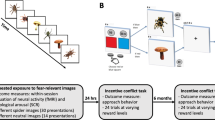Abstract
In the present study, spider-phobic children (N = 22) were exposed to subliminal presentations of spiders, snakes, and mushrooms, while skin conductance responses (SCRs) were measured. In addition, pre- and post-treatment symptom severity data were obtained. As a group, spider-phobic children did not react with differential SCRs to masked phobic pictures. In addition, no convincing evidence was found to suggest that individual variation in differential SCRs to phobic stimuli is linked to pre-treatment symptom severity or therapy outcome. These findings cast doubts on the idea that phobics' phenomenal experience of their fear as irrational and uncontrollable is a result of pre-attentive physiological fear activation.
Similar content being viewed by others
REFERENCES
American Psychiatric Association (1987). Diagnostic and Statistical Manual of Mental Disorders, Third Edition, Revised. Washington D.C.: American Psychiatric Association.
American Psychiatric Association (1994). Diagnostic and Statistical Manual of Mental Disorders, Fourth Edition. Washington D.C.: American Psychiatric Association.
Arntz, A., Lavy, E., van den Berg, G., & van Rijsoort, S. (1993). Negative beliefs of spider phobics: A psychometric evaluation of the spider phobia beliefs questionnaire. Advances in Behavior Research and Therapy, 15, 257-277.
De Jong, P. J., & Merckelbach, H. (1991). Covariation bias and electrodermal responding in spider phobics before and after behavioural treatment. Behaviour Research and Therapy, 29, 307-314.
De Jong, P. J., Merckelbach, H., & Arntz, A. (1995). Covariation bias in phobic women: The relationship between apriori expectancy, on-line expectancy, autonomic responding, and a posteriori contingency judgment. Journal of Abnormal Psychology, 104, 55-62.
Globisch, J., Weike, A., & Hamm, A. (1996). Startle reflex modulation during unconscious processing of fear-evoking slides in animal phobics. Psychophysiology, 33, S41 [Abstract].
Hodes, R. L., Cook, E. W., & Lang, P. J. (1985). Individual differences in autonomic response: Conditioned association or conditioned fear? Psychophysiology, 22, 545-560.
Kindt, M., Bierman, D., & Brosschot, J. F., (1997). Cognitive bias in spider fear and control children: Assessment of emotional interference by a card format and a single-trial format of the Stroop task. Journal of Experimental Child Psychology, 66, 163-179.
Kindt, M., Brosschot, J. F., & Everaerd, W. (1997). Cognitive processing bias of children in a real life stress situation and a neutral situation. Journal of Experimental Child Psychology, 64, 79-94.
Kindt, M., Brosschot, J. F. & Muris, P. (1996). Spider Phobia Questionnaire for Children (SPQ-C): A psychometric study and normative data. Behaviour Research and Therapy, 34, 277-282.
Lang, P. J., Öhman, A., & Vaitl, D. (1988). The International Affective Picture System. Gainesville, FL: Center for Research in Psychophysiology, University of Florida, Gainesville.
Lavy, E., & van den Hout, M. A. (1993). Selective attention evidenced by pictorial and linguistic Stroop tasks. Behavior Therapy, 24, 645-657.
LeDoux, J. E. (1994). Emotion, memory, and the brain. Scientific American, 32-29.
Marcel, A. J. (1983). Conscious and unconscious perception: An approach to the relations between phenomenal experience and perceptual processes. Cognitive Psychology, 15, 238-300.
Mayer, B., Merckelbach, H., & de Jong, P. J. (1999). Subliminal phobic stimuli, eyeblink startle responses, and cognitive interference. Submitted for publication.
Mayer, B., Merckelbach, H., de Jong, P. J., & Leeuw, I. (1999). Skin conductance responses of spider phobics to backwardly masked phobic cues. Journal of Psychophysiology, 13, 152-159.
Mayer, B., Merckelbach, H., & Muris, P. (1999). Automaticity and irrationality in spider phobia. Submitted for publication.
McNally, R. J. (1998). Information-processing abnormalities in anxiety disorders: Implications for cognitive neuroscience. Cognition and Emotion, 12, 479-495.
Muris, P., & Merckelbach, H. (1998). Specific Phobias. In A. S. Bellack & M. Hersen (Eds.), Comprehensive Clinical Psychology, Volume 6. Adults: Clinical Formulations and Treatment. Oxford: Pergamon Press.
Muris, P., Merckelbach, H., van Haaften, H., & Mayer, B. (1997). Eye movement desensitisation and reprocessing versus exposure in vivo: A single-session crossover study of spiderphobic children. British Journal of Psychiatry, 171, 82-86.
Muris, P., Merckelbach, H., Holdrinet, I., & Sijsenaar, M. (1998). Treating phobic children: Effects of EMDR versus exposure. Journal of Consulting and Clinical Psychology, 66, 193-198.
National Institute of Mental Health (1992). Diagnostic Interview Schedule for Children (DISC), Version 2.3. New York: New York State Psychiatric Institute, Division of Child and Adolescent Psychiatry.
Öhman, A. (1994). The psychophysiology of emotion: Evolutionary and nonconscious origins. In G. d'Ydewalle, P. Eelen, & P. Bertelson (Eds.), International Perspectives on Psychological Science, Vol. 2. The State of the Art (pp. 197-227). Hove, England: Erlbaum.
Öhman, A., & Soares, J. J. F. (1993). On the automatic nature of phobic fear: Conditioned electrodermal responses to masked fear-relevant stimuli. Journal of Abnormal Psychology, 102, 121-132.
Öhman, A., & Soares, J. J. F. (1994). “Unconscious anxiety”: Phobic responses to masked stimuli. Journal of Abnormal Psychology, 103, 231-240.
Öst, L. G. (1987). Age of onset in different phobias. Journal of Abnormal Psychology, 96, 223-229.
Snodgrass, J., Levy-Berger, G., & Haydon, M. (1985). Human Experimental Psychology. Oxford: Oxford University Press.
Stern, R. M., Ray, W. J., & Davis, C. M. (1980). Psychophysiological Recording. Oxford: Oxford University Press.
Thorpe, S., & Salkovskis, P. (1995). Phobic beliefs: Do cognitive factors play a role in specific phobias? Behaviour Research and Therapy, 33, 805-816.
Author information
Authors and Affiliations
Rights and permissions
About this article
Cite this article
Mayer, B., Merckelbach, H. & Muris, P. Spider-Phobic Children Do Not React with Differential Skin Conductance Responses to Masked Phobic Stimuli. Journal of Psychopathology and Behavioral Assessment 21, 237–248 (1999). https://doi.org/10.1023/A:1022877431975
Issue Date:
DOI: https://doi.org/10.1023/A:1022877431975



